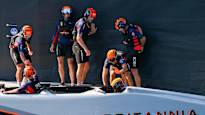It culminated in the Balearic Sea off Barcelona the world’s most famous sailing race, the 171-year-old America’s Cup.
The defending champion of the title, the Emirates Team New Zealand’s Taihoro crew, was challenged by Britannia RB3, which made it to the finals in the qualifying races and is financed by the Ineos industrial group.
In the competition, the round prize goes to the boat crew that first achieves seven start wins. Among the professional sailors of the classic competition, the most famous by far was the captain of Britain Ben Ainsliewho achieved no less than four Olympic victories between 2000 and 2012.
The great specialty of this time’s America’s Cup was the composition of the crews: no less than half of the eight athletes on board during the departures were cyclists, pedaling their ergometers mounted in chambers at sea with frantic power.
They are invited playfully named cyclors, which roughly translates from English to wheel sailer.
The British boat had recruited cyclists from both welding and cycling, the title holder’s boat mainly cycling.
Having followed the America’s Cup intensively for decades, along with Ainslie, achieved Olympic victory in sailing in Sydney in 2000 Jyrki Järvi tells what the heck it’s all about.
“Operation would be impossible”
– Boats need energy on two fronts. Various electronic gadgets such as navigation devices, locators and radios are charged in countries.
– But the bowsail, mainsail and mast are moved by a hydraulic system, where the energy, or hydraulic pressure, is produced only by these cyclists. Their physics is therefore completely decisive for the final result, because without working hydraulics the operation of the ship is of course impossible.
Behind everything is fundamentally the emission-free environmental image desired by sailing, where only wind and muscle power would be utilized and especially not fossil fuels.
Although the cycling chambers are sunk below the deck surface, the energy group could not be placed completely under the deck. Everything has a reason, Järvi explains:
– The America’s Cup boats are single-hulled, but have two foils, i.e. fins. A very small part of the ship touches the water when going to top speeds, i.e. up to 105 kilometers per hour.
– I can tell you that the going is not quite stable, but the jostling and commotion are hellish. At top speeds, there is a risk of accidents, because if the rudder loses its grip, the ship can capsize through the bow or even dive. It’s not good to be under the deck then.
An Olympic champion in the star class died in a training accident like this Andrew Simpsonwhen the catamaran of the Swedish boat team that was aiming for the final capsized off San Francisco in 2013.
A strange environment
Since the cyclists have to be able to produce huge bursts of energy in these extreme conditions, they have been committed to the projects since their beginning, i.e. three years ago, so that there is enough training at sea and the body gets used to the strange environment.
– On the bike, the movements of the boat may feel really powerful, because the athlete is not attached to the deck of the boat with his shoes, but to this device that has to generate energy. It must feel very strange at first, thinks the track cycling coach Mika Simola.
A double number of cyclists have been recruited for the projects for the needs of one start, because a day of two starts after maximum effort is too much for even a hard-working person.
Simola thinks that a very specific type of cyclist has been mapped onto the ergometers’ cranks on top of the lock pedals.
– There is no use for light road cyclists when you have to be able to do absolutely massive, 30-120 second bursts of energy several times with a relatively short recovery. The big muscle bundles of sprinting and keirin are probably out of the game for track cycling, from which unimaginable wattage is released for 10-30 seconds at a time, but endurance runs out.
Under or you can watch from this linkwhat energy production looks like in America’s Cup boats.
According to Simola, the needs of the America’s Cup are best served by the characteristics required by the four-kilometer time trial and the madison competition format, which lasts up to an hour.
In the crew of the American Magic boat, the world champion of the first-mentioned form of competition tried for the final, American Ashton Lambie. The energy producers of the British finalist included, among others, Harry LeaskOlympic silver medalist in welding from Tokyo 2021.
Sweden already tried in 1977
Before the wheelers connected to the hydraulic system, the sails and mast were operated by a mechanical system that worked on crank wheels pulled by men called grinders.
Jyrki Järvi knows that the Swedish boat crew, which was left out of the finals, tried to use cycling-based, then mechanical energy production as early as 1977. The technology is now from another planet.
See below or from this linkhow the “cycle sailors” of the New Zealand team train.
Ineos operate your own The Grenadiers professional cycling team, which is the best in the world. Ineos also financed a special marathon run in Vienna, where Eliud Kipchoge 2019 broke the ghost limit of two hours in non-record-worthy conditions.
The sustainability project was also the race boat construction and design: 35,000 man-hours were spent on design, 50,000 man-hours on construction.
– According to the best available information, Ineos put a total of 250 million euros into this America’s Cup project. When the company has its own professional cycling team, in general a great interest in endurance sports and a massive amount of research data, surely no stone was left unturned in this field, Järvi assures.
